
MUSEUMS AND LIBRARIES (12 sites)021 - Canterbury Museum, Christchurch, New Zealand.BYRD HOUSES (3 sites)
046 - U.S. Navy Museum, Washington, DC, USA.
048 - Mariners' Museum, Newport News, Virginia, USA.
052 - Naval Academy Museum, Annapolis, Maryland, USA.
083 - Tamworth Historical Society, Tamworth, New Hampshire, USA.
105 - Peterborough Historical Society, Peterborough, New Hampshire, USA.
174 - New England Ski Museum, Franconia, New Hampshire, USA.
264 - Handley Library, Winchester, Virginia, USA.
329 - American Clock and Watch Museum, Bristol, Connecticut, USA.
360 - Peabody Essex Museum, Salem, Massachusetts, USA.
557 - Archives, The Ohio State University, Columbus, Ohio, USA.
572 - Newberry Library, Chicago, Illinois, USA.
263 - Richard E. Byrd's birthplace site, Winchester, Virginia, USA.CLUBS (1 site)
018 - Richard E. Byrd house, 9 Brimmer Street, Boston, Massachusetts, USA.
712 - Fairwood, summer home of Richard E. Byrd, Dublin, New Hampshire, USA.
863 - Wickyup. summer home of Richard E. Byrd, west of Cherryfield, Maine, USA.244 - Explorers Club, New York, NY, USA.PUBS, HOTELS AND RESTAURANTS (2 sites)
057 - Ebenezer's Place, Framingham, Massachusetts, USA.SHIPS, BOATS, PLANES AND TRAINS (AND BITS OF SAME) (5 sites)
103 - Little America, Wyoming, USA.
070 - Byrd's aircraft, Stars & Stripes, Sandston, Virginia, USA.SCHOOLS (6 sites)
529 - Figurehead from the Bear, Boston, Massachusetts, USA.
392 - Byrd's aircraft, Floyd Bennett, Henry Ford Museum, Dearborn, Michigan, USA.
496 - USS Richard E. Byrd.
747 - USNS Richard E. Byrd.
502 - Richard E. Byrd Elementary School, Yokohama, Japan.GRAVES, CAIRNS, MEMORIALS, STATUES (12 sites)
503 - Admiral Richard E. Byrd Middle School, Winchester, Virginia, USA.
526 - Admiral Richard E. Byrd Elementary School, Elk Grove Village, Illinois, USA.
531 - Richard E. Byrd Community Academy, Chicago, Illinois, USA.
681 - Richard E. Byrd Middle School, Sun Valley, California, USA.
556 - Byrd Polar Research Center, Ohio State University, Columbus, Ohio, USA.013 - Byrd statue, Arlington National Cemetery, Arlington, Virginia, USA.PLACES (3 sites)
072 - Byrd's grave, Arlington National Cemetery, Arlington, Virginia, USA.
330 - Boulder slated for Byrd' gravestone, University of Maine, Orono, Maine, USA.
028 - Grave of Igloo, Dedham, Massachusetts, USA.
014 - Byrd bust, McMurdo Station, Ross Island, Antarctica.
063 - Byrd bust, Unity Park, Dunedin, New Zealand.
044 - Byrd Memorial, Mt. Victoria, Wellington, New Zealand.
265 - Byrd statue, Winchester, Virginia, USA.
737 - Byrd statue, Punta Arenas, Chile.
072 - Bernt Balchen's grave, Arlington National Cemetery, Arlington, Virginia, USA.
587 - Finn Ronne's grave, Arlington National Cemetery, Arlington, Virginia, USA.
637 - Carl Eklund's grave, Arlington National Cemetery, Arlington, Virginia, USA.
053 - Chinook Kennels, Wonalancet, New Hampshire, USA.TOPOGRAPHIC FEATURES (1 site)
027 - Quail Island, Lyttelton Harbour, New Zealand.
266 - Richmond International Airport, Richmond, Virginia, USA..
859 - Moon crater named for Richard E. Byrd.OTHER AND SUNDRY (1 site)
040 - American flag from Byrd, Lincoln, New Hampshire, USA.
MUSEUMS AND LIBRARIES
Canterbury Museum.
Rolleston Avenue, Christchurch, New Zealand.
http://www.canterburymuseum.com
Some of the many items at the Canterbury Museum. Christchurch's Canterbury Museum is well known to most Antarcticans. Its collections displayed in the 'Sir Robertson Stewart Hall of Antarctic Discovery'—opened in 1977 and refurbished since my last visit so there may have been some rearrangement—are extensive, expansive and important; and I'm sure there's a lot more stashed away in the back rooms! Is there any doubt that this is the most comprehensive collection of Antarcticana anywhere? Very centrally located on Rolleston Avenue and adjoining the superb Botanic Gardens, the Museum's a must for all those visiting New Zealand. (Tip: When I was last there I stayed at the nearby, modern and affordable YMCA.)What are some of the highlights? Among the artifacts that caught my fancy were a china plate from HMS Erebus; a compass and sextant from the Southern Cross expedition; quite a few philatelic items; busts of Scott (by his wife), Shackleton, Amundsen, Byrd and Mawson; Hurley's Kodak Model B pocket camera; Amundsen's sledge with its zinc runner plates, the Norwegian flag flown at the Pole and his pocket knife; an oil painting of Shackleton's Nimrod done on a venesta case board (also used to bind copies of the Aurora Australis); Scott's ceremonial hat, belt, epaulettes, sword, polar medal and Legion of Honor (wolfskin gloves, too); Shackleton's Arrol Johnson motor sledge; a bottle of champagne (Methuselah size - 6-1/2 quarts!) emptied in celebration of Byrd's safe return from the first flight to the Pole (inscribed by expedition members); Wilson's microscope; a box of cigars from Scott's last expedition with typed inscription "for final dash, compliments of the Sol factory, Havana;" original plan and inscription for the Cape Evans cross in memory of A. E. Mackintosh; and the silver communion vessels from Scott's Cape Evans hut. And that's just for a start!
By the way, don't miss the associated P.J. Skellerup Antarctic Library.
[Episode 28, Low-Latitude Antarctic Gazetteer, posted 28 November 1996.]

U.S. Navy Museum.
Building 76, 805 Kidder Breese SE, Washington Navy Yard, Washington, D.C. 20374-5060, USA.
http://www.history.navy.mil/branches/nhcorg8.htm
This being Memorial Day it's appropriate that we visit the Washington Navy Yard in Washington, D.C. You'll find there the Navy Museum, a cavernous warehouse full of interesting exhibits including a large one devoted to polar subjects, both north and south. Byrd's famous hut (Alone) is recreated, and there is on display a variety of odds and ends such as radio equipment, clothing, and the original stove with kerosene burner that almost led to disaster. On the roof of the hut are two stuffed penguins: an Adelie and an Emperor. Included in the exhibit are polar medals, extensive collections of Finn Ronne and Byrd memorabilia, a 1965 1"=100' model of McMurdo Station, numerous examples of expedition china and even Byrd commemorative wood matches and paper cups and two tires from a Ford Trimotor. There's both an oil portrait by J. G. Cowell of Byrd and and a 30-inch high statuette (by deWeldon from the looks of it). Some Scott items are on display, too: a Wilson watercolor, a telescope with Scott's name engraved on it and several items (a theodolite, a film container and chocolate) lent by the Mariners Museum in Newport News. There are two fine ship models: The Flying Fish (Wilkes) and the Astrolabe (Dumont D'Urville) crafted of ivory. A large collection of papers and artifacts concerning both American and British Antarctic exploration are at the Navy Yard, catalogued but not on exhibit. Charles Wilkes' pistol is here as is his copy of the History of Greece (London, 1829), not to mention a cake of hand soap and a box of matches from Shackleton's hut at Cape Royds, a wood fragment from the bow of Ross's HMS Erebus and a variety of food rations from Scott's last expedition.Since September 11th it's not been easy to get into the Navy Yard. The Musem's website doesn't help much (www.history.navy.mil/branches/nhcorg8.htm). So a phone call should be made before attempting a visit: 202-433-4882. Views below, l to r: 1) Exterior of the museum; 2) Commemorative paper cups; 3) Display case with several Byrd items including a model for a de Weldon statue; 4) The reproduction Alone hut.My guess is that this collection—displayed and otherwise—qualifies as the largest in the U.S.
[Episode 9, Low-Latitude Antarctic Gazetteer, posted May 27, 1996.]

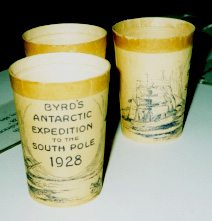


Mariners' Museum.
100 Museum Drive, Newport News, VA 23606, USA.
The Mariners' Museum is among the world's premier maritime museums. Its collections include some interesting Antarcticana: There's a bit on the Wilkes expedition. The item that I'd like to spend some time with is the journal of Lt James Alden who was on the Vincennes. The log covers the period Wednesday 7th Aug 1838 (reported to duty at Norfolk, Virginia) and ends on Sunday May 22, 1842. The entry for Janurary 28, 1840 reads: "At 9.45 A.M. discovered land."Among the Byrd items (descriptions in quotes are form Museum's website):
1) Model of the Bear of Oakland made by Albert Krug. (Accession number 1940.0018.000001)
2) Figurehead from the Bear of Oakland. (Accession Number: 1935.0047.000001) "White painted full-length polar bear with extended fore paws, seated on gilt acanthus leaf design and black painted base. Large grooved back with four bungs (one on upper chest missing cover). Realistically painted face. Gilt volute design extends to stomach. Modern metal mounting bracket and base plate.
NOTES: Figurehead attributed to the steam auxiliary barkentine BEAR, built by A. Stephen and Sons, Dundee, Scotland in 1874. This appears to be original figurehead. Other than replacement "bears" for vessel, no other bear figurehead is known. The figurehead was presented to the museum by Admiral Richard Byrd." See photo below from Museum's website. See also a later figurehead (No. 529 below ) that's in Boston and the ships bell that is in the Explorers Club (No. 244 below) in New York.3) Parka. (Accession number 1940.0018.000001) "This parka was made by the tailor to the Byrd Antarctic Expedition II, aboard the BEAR OF OAKLAND, while in route to Little America in 1933. It is one of 2 dozen such garments unused by members of the expedition. It is made of heavy woolen blanket cloth and is very baggy and warm. Object is in two parts, first is a parka, second is a pair of matching pants." See photo below from Museum's website.
4) Plaster bust of Byrd. (Accession Number: 1965.0013.000001) See photo below from museum's website.
5) Soup plate from the City of New York. (Accession Number: 1936.1482.000001) "Ceramic soup plate with a view of two ships with inscription and a picture of an airplane and a dog. All pictures on the border of the plate. INSCRIPTION: Byrd Antartcic Expedition I (by print of the CITY OF NEW YORK), Byrd Antarctic Expedition II (by print of the BEAR OF OAKLAND), With best wishes from Fraunfelter China Company, Zanesville, Ohio (written on back)." See photo below from Museum's website.
According to the Museum's website, there are another 21 items with a Byrd connection: Flag carried over South Pole (see Nos. 052 and 040 below), Glass tumbler, Flag (pennant), Two gangway boards, Horseshoe, Ink drawing, Milk bottle cap (see No. 105 below), Painting of the Bear by Thomas Skinner, Telescope, Compass, Two different prints of the U.S.S. Glacier, Print of R.E. Byrd by Ralph Barnaby, Quartermaster's slate, Rock fragment, Commemorative medal, Model of the U.S.S. Glacier, BAEII badge, Print of the Bear of Oakland by Gordon Grant, Distingished Flying Cross (presumably Byrd's although not identified as such).
When searching under 'Antarctic' in the library catalogu, there were 300 hits, these presumably not including rare books and manuscripts. There seem to be two special collections that might contain interesting Antarctic material: Robert G. Skerrett Collection: 1880s-1940s. Aeronautics; Diving; RMS Lusitania; Naval Aviation; Naval Medicine; SS Normandie; Robert Peary; Polar Exploration; Salvage; Ship Launchings; Steamships; Submarines; Torpedoes; US Navy; World War II--newspaper and magazine articles, correspondence, ephemera, government papers, manuscripts, patents, photographs, plans (MS163) and the D. F. Welch Collection: 1910s. Antarctic Exploration; Scott Expedition--photographs (MS264).


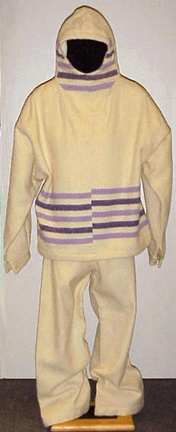


Naval Academy Museum.
Preble Hall, 118 Maryland Avenue, U.S. Naval Academy, Annapolis, MD 21402-5034, USA.
http://www.nadn.navy.mil/museum
This is a nicely laid out museum on the campus of the Naval Academy. Among its holdings—not all on display—are: • An eight-foot sledge used by Byrd on BAEI (pictured below), made by S. Strom and presented to the Museum by Mrs Marjorie Meriweather Post. • A sledge with Scott connections, found at McMurdo Sound and presented by Cdr. G.L. Ketchum, USN, in 1948. Made by L.H. Haben & Co., Christiana. Nearly 12 feet long. • Portrait of Lt Charles Wilkes by Thomas Sully (1783-1872), oil on canvas, dated 1843, 29-3/4 x 25". An engraved version was used in Wilkes' book. Presented by the Wilkes family to the Museum on 21 November 1929. • Oil portrait of Byrd. 40 x 30". Dated ca. 1927. Painted by Duncan. Gift of Louis Storgion, 1974. • Bottle of water from an ice core that has been used in a senior event at graduation (where water from all the oceans are mixed together and graduates drink? from the mix). • Bronze bust of Byrd, on display (pictured below). Set on a marble stand with bronze plaque reading: RADM Richard E. Byrd, Jr. USN 1888-1957 by Benjamin T. Gilbert Presented by Mrs Benjamin T. Gilbert. 21 x 17 x 10". • In glass case: Dress chapeau of Commodore Charles Wilkes USN, who commanded the U.S. Exploring Expedition to the Antarctic 1838-42. This is the regulation cocked hat of 1841. Presented by Mrs C. D. Hull. • Sextant used by Surgeon John L. Fox, USN on the Wilkes Antarctic Expedition 1838-1842. Presented by his son, Rear Admiral Charles E. Fox and his grandsons Edward G. B. Fox and Lcdr J. L. Fox, USN. • Gold medal in glass case. "Patron's gold medal of the Royal Geographical Society, London, awarded to Captain Edwin A. MacDonald NA '31 for Antarctic "Operation Deepfreeze." Gift of Mrs MacDonald. • American flag, ca. 18 x 30", flown by RADM R.E. Byrd over the South Pole during Operation Highjump, 12 February 1947. Gift of Alan B. Shepard. • Byrd's gold Antarctic Expedition Medal. Sixty-six were struck in gold, seven in silver and nine in bronze. Gift of L.A. Lofgren, 1987.




Tamworth Historical Society.
24 Greg's Way, P.O. Box 13, Tamworth, NH 03886, USA.
The Tamworth Historical Society has a small display on the Chinook Kennels which were in Wonalancet, a village of Tamworth, The collection includes photographs, awards, signs, souvenirs, posters, flags, etc. • Photo of Ed Moody and team. • Photo of Arthur Walden's Chinook. • Various newspaper clippings. • Photo of Byrd and Eva "Short" Seeley. • Various buttons, cups, etc. • Two pairs of snowshoes worn by Arthur Walden on the first Byrd expedition. • Posters featuring 'Dogtown.' • Small American flag with a letter on 9 Brimmer Street stationery that reads: "My dear John Finley, I am happy to present to you this American flag I carried for you on our flight to the South Pole. With high admiration and regard, Your friend, Dick Byrd Dec 30, 1930." • Also on the wall is a Radiogram: to Dr John Finley dated June 4, 1929. "Dear Dr Finley, Due to my very high regard for you I have decided to name the trail to the Bay over which we carried hundreds of tons of material, the John Finley Trail. We hope also to be able t o put your name on the map on this side. Best of good wishes. Dick Byrd."
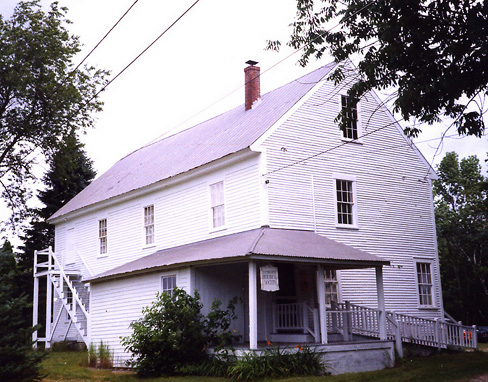
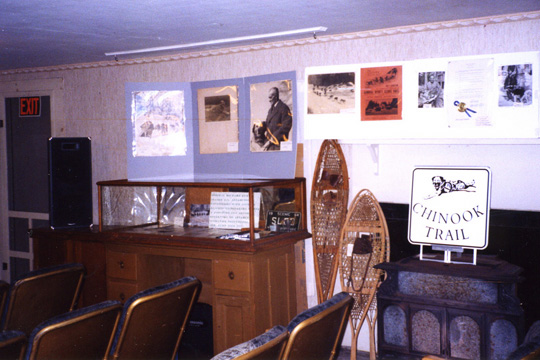
Peterborough Historical Society.
19 Grove Street, Peterborough, NH 03458, USA.
http://peterboroughhistory.org/ColdCows.htm
Some cows that headed south in 1933. Quite by chance I came upon a site of Antarctic interest in the historical society in Peterborough, the next town to mine in New Hampshire. The Guernsey Cattle Club was located for many years in Peterborough and apparently its public relations director made arrangements for three Guernsey cows to accompany Byrd on his second expedition in 1933. A display on the second floor has the following caption: "On Saturday, October 7, 1933, Admiral Richard E. Byrd asked for the loan of three Guernsey cows to take to the Antarctic with him in order that the men might have some fresh milk on the trip. Cows from Deerfoot Farms, Southboro, Massachusetts, Emmadine Farm, Hopewell Junction, New York and Klondike Farm, Ellan, North Carolina, were loaded on the supply ship Jacob Ruppert. In addition to sand and straw for bedding a two-year supply of hay, beet pulp, grain and bran were loaded as well as a supply of milk bottle caps reading 'Byrd Antarctic Expedition, Golden Guernsey Milk Produced on Board the Jacob Ruppert.'" The three quiet Guernseys were persistent milkers and returned from Antarctica after 22,000 miles of sea travel with a new bull calf christened Iceberg. Iceberg was born 275 miles north of the Antarctic Circle on December 19th; all hoped that the birth would be truly an Antarctic event but it was not to be. The cows were named after the farms they came from: Deerfoot, Emmadine & Klondike. The last, alas, contracted frostbite and had to be destroyed. Cox (who carried out the deed) is quoted, on p. 334 of Discovery, as saying "I've put away a lot of 'em, Admiral," he said, "but it never got me before. I guess I got pretty fond of that cow." Other references to the cows appear on pp. 24, 36, 37, 38, 184, 189 & 381. At Little America there was a Cow Barn (15x31x8 feet) complete with an electric milking machine. A medal was struck memorializing these Antarctic "explorers" and one is on display at the Society (pictured below). Also, a model of the crate and sledge (pictured below) used to transport the cows and an original Boston Herald cartoon (by Francis W. Dahl) featuring the cows and signed by over 70 of the expedition party (pictured below). I wonder whether these were the first cows to make it south or winter over. Have any done so since?
[Episode 7, Low-Latitude Antarctic Gazetteer, posted May 13, 1996.]
After posting this I received a letter from Joe Merriam, a friend of mine. He wrote:In the summer of 1942 I was one of 8 or 10 youngsters who took temporary jobs at the huge Deerfoot Farm in Southborough, Massachusetts. This farm must have owned or rented some thousand acres of arable land and pasture, it had a large barn and milking sheds for 200 cows—Guernseys, Holsteins and Jerseys, with silos, a dairy, and other outbuildings. Not one vestige of this immense establishment remains today, it's all developed into houses, lawns with barbecues, a suburban landscape. Pride of place in the first cowshed belonged to an old Guernsey cow who had spent 1930 with Admiral Byrd in Little America. She had grown a shaggy coat in the severe Antarctic conditions, and had never lost it. A placard gave her history and name, I can't recall the name but she was referred to, disrespectfully, by the barn-workers as "Lady Deerfoot," being old and rather wilfull. By 1942 she had ceased to yield much milk; and I remember the farm superintendent, "Daddy" Deering, conversing with the farm manager, Mr. Sayles, as to whether they should get rid of her. Indeed she disappeared that same summer, to the best of my recollection. Those were war-time days, and not much sympathy was shown for an animal of great historic interest, but no longer productive.

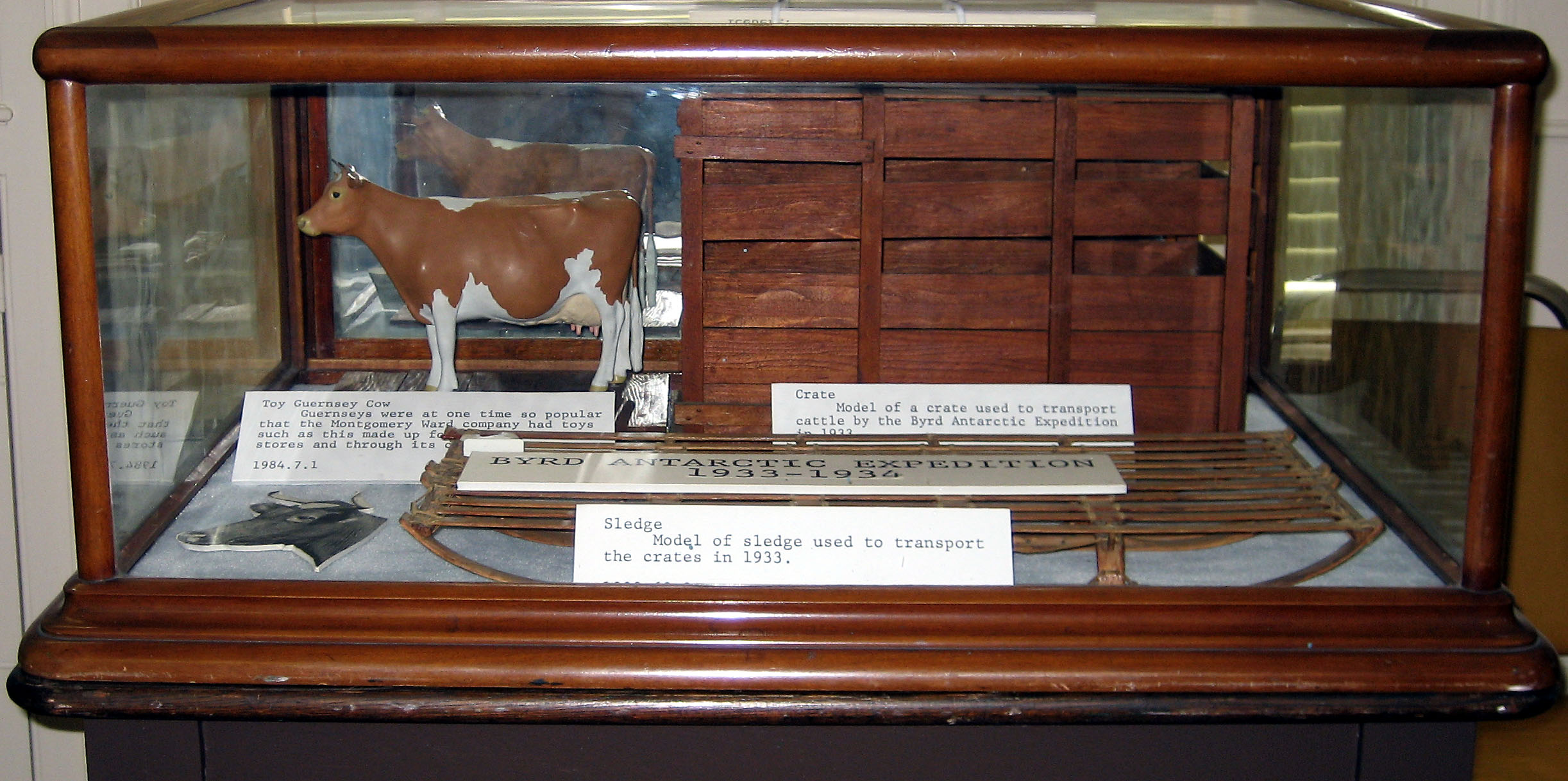

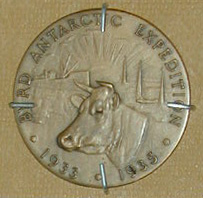

New England Ski Museum.
Franconia Notch Parkway Exit 4, P. O. Box 267, Franconia NH 03580-0267, USA.
George A. ("Mike") Thorne was a member of the shore party during Byrd's 1928-30 expedition. He took part in Gould's Southern Geological Party of December 1929. His skis are in this museum.

Handley Library.
Corner of Braddock and 100 West Piccadilly Street, P. O. Box 58, Winchester, VA 22604, USA.
http://www.hrl.lib.state.va.us
This impressive beaux-arts library in Richard Byrd's hometown of Winchester, Virginia, has a collection of Byrd material: "This collection contains correspondence, photographs, news clippings, awards, newsletters, speeches and other materials relevant to Admiral Richard E. Byrd (1880-1979) and his expeditions to Antarctica." It consists of three boxes. Among the items I found interesting:• Byrd's bookplate.
• A plaque from the U.S.S. Richard E. Byrd.
• Honors and awards presented to Richard E. Byrd, catalog of items sold by Sotheby's, 1 item, printed; 14 loose pages, printed.
• Scrapbook of news articles covering Admiral Byrd's Expedition to Antarctic, 1928-1930.
• Telegrams between Richard E. Byrd and citizens of Winchester, 1926.
A complete listing may be found at http://www.hrl.lib.state.va.us/handley/archives/Byrd,%20Richard%20E%2028.htm

American Clock and Watch Museum.
100 Maple Street, Bristol, CT 06010, USA.
This museum, situated in an historic house in the center of Bristol, has the following items associated with Richard Byrd:• A wristwatch with leather strap (pictured below). "This wristwatch was worn by George Norville, executive officer on the Admiral Byrd expedition."(label). The watch: Wittnauer "Indestructo"(on dial); "Contracid 7066" on back.
• "Combination 8 Day Clock & Timing Chronometer used for experiments"(label). Black dial. Silver. No markings except "Wittnauer Swiss Made" on dial.
• Two commemorative pocket watches. 1). "The Explorer" on dial with Ford Trimotor above. On back engraved: "Wings over the Pole The Explorer." With scene showing plane, ship, base, ocean, land. Inside: Made January 1931.
2). "Little America" Above a globe. On back engraved: Plane, two explorers, sledge, ship. Inside: Made June 1929.• One clock mounted on a wood panel (pictured below). "Eight-day Wittnauer" with black face.
• Two clocks mounted on a wood panel (pictured below). Both black faces. One on left is an eight-day clock.
• Also in the collection is a die for another engraved back: "Trail Blazer" at top, showing ship, plane, globe, Byrd, two flags. "Commemorating Byrd's Antarctic Expedition."
• These items were re-discovered in 1994 by Mark Green of Lux, Bond and Green, a jeweler in Hartford, CT. They were found in a safe in the store.




Peabody Essex Museum.
East India Square, Salem, Massachuusetts 01970-3783, USA.
The Antarctic highlight of the Museum's collection is a painting of the Vincennes by Charles Wilkes, who turns out to have been a very accomplished artist. The Vincennes was the flagship of Wilkes' U.S. Exploring Expedition.Included in the Museum's extensive holdings is the A. H. (Amory H. "Bud") Waite Collection. Waite was on the Second Byrd Antarctic Expedition and gave his collection to the Museum. (His papers are held by The Ohio State University). Here's the complete listing:
The following are a gift of A.H. Waite [only Antarctic items included]:Specimens collected on his various trips to Antarctica with Byrd and later trips. 1970. See File M14342-14412. Acc. #19497
M-14342. 1 tin petrol can used in the 1910 Antarctic Camp of Captain Robert Falcon Scott.
M-14343. 1 dog harness 35" long from Admiral Byrd's Antarctic Expeditions #2 1933-35.
M-14345. Brass plate from a life boat built in Scotland in 1871, presumably for the ship BEAR.
M-14347. Antarctic typical black flag used by present day Antarctic Expeditions.
M-14348. Ant.-typical orange flag use by present day Antarctic Expeditions.
M-14349. Ant. tin can containing [previous crossed out] eskimo biscuits from Scott's & Shackleton's Ant. camp 1902-7, recovered by A.H. Waite 1958-1962 7" diam 4-1/2" high.
M-14350. Remains of a blue and white cargo parachute dropped at the South Pole, approx. 9' in dia.
M-14351. Jar of sugar from Scott's 1910 base at the South Pole [question mark inserted here].
M-14352. Can of Spice - from Scott's camp.
M-14353. Can of Pemmican from Scott's camp.
M-14354. Can of "Symmington's Pea Flour" from Scott's base.
M-14355. Can of cocoa from the same base.
M-14356. Ant.- can of army rations from Shackleton's 1907 base.
M-14357. Copy of ensignia of the Signal Corp Antarctic Research Team, developed by A.H. Waite 11-1/4" diameter.
M-14358. Wooden copy of an old fashioned straight razor made on the BEAR in 1933, used to initiate the "polywogs" on that equator crossing. The names of the entire crew of the ship BEAR are inscribed on the blade (damaged) 26" long.
M-14363. Piston from a Citroen engine used in the first tractor exploration of the Antarctic in 1935.
M-14365. Ant.- fragment of bottle glass, an old belt buckle, a handmade hinge, a tin can cover and 6 nails. The glass fragment, buckle, and hinge were found at a campsite on the Northeast coast of Greenland. The tin can cover is from Eta, Greenland and the 6 nails came from Scott's base in the Antarctic.
M-14366. Ant.-part of the first antenna wire ever used in the Antarctic, used by Scott and his party in 1902, found in 1956 by A.H. Waite, (bent and twisted) approx. 30' of wire.
M-14367. Ant. and Arctic flag carried by A.H. Waite to the Arctic and Antarctic as leader of the Signal Corp Research Teams (very dilapitated).
M-14368. Ant.-Chemical jar from Scott's base with remains of specimens inside.
M-14369. Ant.-tin of waterproof matches recovered from Shackleton's 1907 hut.
M-14370. Ant.-boot sole with corroded aluminum ground plates, found outside Scott's 1910 house (just remnants).
M-14371. Ant.-knife found in Scott's 1910 house by A.H. Waite in 1956, American Expeditions. 10-1/2" long.
M-14372. Ant.-windproof shirt issued to A.H. Waite at Little America in December 1933.
M-14373. Ant.-windproof shirt of the same type as above only in better condition.
M-14374. Ant.-socks of the same type of material.
M-14375. Ant.-fragment of a trail flag brought back from Little America by A.H. Waite 16 x approx. 7".
M-14376. Ant- boot strap from Scott's 1910 hut.
M-14377. Ant.-fragment of a sled rope found in Scott's 1910 hut 7" long.
M-14378. Ant.-spool of thread found at Shackleton's hut, originally made in England before 1907. 2" spool.
M-14379. Ant.-spool of thread with a needle in it from Scott's 1910 hut. 2 " spool.
M-14380. Ant.-jar of cocoa from Scott's base.
M-14381. Ant.-box containing two of the original battery cells used by Scott and his crew.
M-14382. Ant.-leather washer used on an early British ski pole to keep it from sinking too far into the ice.
M-14383. Ant.-ski strap found at Scott's base 21" long
M-14384. Ant.-staple from one of the ship riggings from Cape Royds, which was Shackleton's.
M-14385. Apiece of the figurehead of the ship BEAR, brought back by Admiral Byrd in 1935. 11-1/2" long (this piece fits exactly with M-4396).
M-14386. Ant.wind helmet used by A.H. Waite for skiing in the Antarctic in 1933-4-5 and later in 46-47, 55-56-57.
M-14387. Ant.- a piece of the original sail of the ship DISCOVERY 190 [last digit clipped] 18-1/2" long 4" wide.
M-14388. Ant. - one of the original binding posts from one of Scott's early storage batteries.
M-14389 [and] M-14390. Ant. - a spent cartridge shell, and a small glass bottle recovered by A.H. Waite from Cape Royds, Shackleton's 1907-1915 camp.
M-14391. Ant. - bottle with an eyedropper in it, found in the Photographic laboratory of the 1910 Scott camp.
M-14392. Ant. - test tube in original wrapping paper from Scott's 1910 expedition.
M-14393. Ant. - broken glass fragment found at Scott's 1910 base weathered purple and worn by sand.
M-14394. Ant. - sugar bottle cover 3-1/2" in diameter, from Scott's 1910 base.
M-14395. Ant. - marmalade can label from Scott's 1910 base.
M-14396. Ant. - can of food recovered by A.H. Waite from Cape Royds, Shackleton's 1907 and 1915 camp.
M-14397. Ant. - gray woolen shirt made by Woods and given to the Byrd Antarctic Expedition by him, issued to A.H. Waite at Little America.
M-14398. Ant. - pair of khaki windproof trousers made for A.H. Waite.
M-14399. Ant. pair of trousers worn by A.H. Waite, patched with sheepskin on the knees and seat.
M-14400. Ant.- windproof sock of Byrd cloth used in Little America.
M-14401. Ant. - Army issue winter Arctic hat worn by A.H. Waite.
M-14402. Ant. no description
M-14403. Ant. pair of standard army issue boots worn by A.H. Waite.
M-14404. Ant. -pair of felt innersoles used by A.H. Waite.
M-14405. Ant. -pair of air force boots issued to pilots for Arctic wear.
M-14406. Ant. -pair of bamboo ski poles used by A.H. Waite in the Antarctic in 1934 54-1/2" long.
M-14407. Ant. -Byrd issue of the early Scott man-hauling harness.
M-14408. Arct. -Standard pair of army snowshoes, developed by the Natick Laboratories, Natick, Mass. Environmental Lab. for the use of army troops in the Arctic, used by A.H. Waite 57-1/4" long.
M-14409. Ant. -Typical crampons issued to all Byrd Expedition personnel, used by A.H. Waite.
M-14411. Ant. -Box kite used by Admiral Byrd on his first Antarctic Expedition and repeated on his second expedition. It carried antenna wires aloft for better radio transmissions; later proved unneccessary (dismantled).
END OF ACC. # 19497 [Those not appearing are arctic or otherwise non-antarctic]

The Byrd Polar Research Center Archival Program, The Ohio State University.
2700 Kenny Road, Columbus, OH 43210-1046, USA.
http://library.osu.edu/sites/archives/polar
The Byrd Polar Research Center Archival Program (BPRCAP) is a collaborative effort of the Byrd Polar Research Center and The Ohio State University Archives. Its mission is to collect, preserve, and provide access to historical documents concerned with polar regions. The Byrd Polar Research Center Archival Program (BPRCAP) has the papers—letters, diaries, photographs, reports, expeditionary records, and more—of explorers and scientists who have contributed to knowledge of polar regions. Particularly noteworthy are the following specific collections: • The Papers of Admiral Richard E. Byrd — who flew over the North and South Poles and was a pivotal figure in the modern exploration of Antarctica. • The Papers of Sir George Hubert Wilkins — the first to fly an airplane in Antarctica, to fly across the Arctic Circle, and to take a submarine under polar ice. • The Frederick A. Cook Society Collection — Dr. Frederick A. Cook was a hero of the Belgica Expedition (1897-99) to Antarctica and one of the first claimants to the North Pole. • The records of the American Polar Society — Founded in 1935 and guided by August Howard for many years, the Society continues to foster interest and provide information about polar regions, especially through its publication, The Polar Times. • Polar Oral History Program — The documenting of the early years of American polar exploration by interviewing those who were in the polar regions since the 1930s. • Other Collections — The BPRCAP also holds the papers, photographs and other historical documentation of other polar explorers and researchers." Among those associated with Richard Byrd whose papers are included in the BPRCAP collections:• Bramhall, ErwinSource: From the archives website.
• Bryant, Glenn H.
• Goodale, Edward
• Konter, Richard
• Lindsey, Alton A.
• Lofgren, Charles
• Robinson, Russell
• Siple, Paul
• Waite, Amory "Bud"
• and perhaps others


Newberry Library.
60 West Walton Street, Chicago 60610, Illinois, USA.
This marvelous independent research library has a large polar collection mostly donated by Gerald F. Fitzgerald. Among its Byrd holdings, other than the usual books, are: a pair of reindeer mukluks owned by Byrd and a very nice pencil and pastel study of Byrd in furs and Igloo by Richard B. Adam, dated 1928.

BYRD HOUSES
Richard E. Byrd's birthplace site.
326 Amherst Street, Winchester, Virginia, USA.
The house no longer stands; it is now a used car lot. There is a Virginia historical sign on the street at the site.Site No 018The plaque reads:
Q 4-g
Rear Admiral Richard E. Byrd
25 October 1888 - 11 March 1957
Here was born and reared Richard Evelyn Byrd, | aviator and polar explorer. A 1912 U. S. Naval | Academy graduate, he received the Medal of | Honor for the first flight over the North Pole | in 1926, and made the first commercial nonstop | transatlantic flight. In 1928 he organized | and led the first of five Antarctic expeditions, | and flew over the South Pole in 1929. Byrd spent | the winter of 1934 alone a hundred miles from | his base at Little America, conducting scientific | experiments. Of his several books, the best | known is Alone. Byrd is regarded as the father | of the Antarctic Peace Treaty, which bans the military use of Antarctica. He is buried in | Arlington National Cemetery. | Department of Historic Resources 1993.


Byrd's Boston home.
9 Brimmer Street, Boston, Massachusetts 02108, USA.
Richard Byrd's wife, Marie Ames, was a Bostonian and this house—No 9 Brimmer—on the "flats" of Beacon Hill stands next door to No 7 which was her family's house. At one time the two houses were connected and the family made use of both. The Admiral lived here for 27 years and died here on 11 March 1957. (Their son, also Richard, continued to live here after his parents' deaths.) The older photo below shows the family, including Igloo on the steps. Daughter Bolling Byrd Clark is in the front center holding the family cat.


Fairwood.
Old Marlborough Road, Dublin, New Hampshire, USA.
The Byrd family rented this grand house for the summers of 1930 and 1931. In all likelihood a good bit of Little America was written here. Byrd's presence in the small town was biggest thing to happen in a long time and numerous articles about the famous explorer appeared in the local press. More recently, the Monadnock Ledger had this to say about his time in Dublin in its issue of June 12, 2003:The older view below is from the collection of the Dublin Archives, Dublin, New Hampshire.New England. A Look Back
by Jane Eklund Byrd summers in Dublin
World-famous explorer rented mansion in 1930 DUBLIN — It's true winters can be pretty bad around here, and even more so in Dublin than some of the other Monadnock region towns, but that's not the reason Admiral Richard Byrd came for an extended visit. The famous polar explorer came for the summer, in fact. The year was 1930, four years after the famous naval officer and aviator claimed to have flown over the North Pole (a claim later questioned by scholars, according to a Byrd website maintained by the Ohio State University), and one year after his flight over the South Pole. He came to Dublin to spend the warm months writing about his South Pole expedition and getting ready to undertake a lecture tour in the fall, according to the new Dublin town history, "Village on a Hill," which describes the excitement generated in town by Byrd's visit. His arrival was first announced in local newspapers, which reported that Byrd had rented the Charles Aldrich mansion on Old Marlborough Road for the summer. "Not since the arrival of Mark Twain back in 1905 had there been such a stir," writes Tom Hyman, author of "Village on a Hill." Local people were keen to get a glimpse of Byrd, or at least of the house where he was staying. They made their way to the Aldrich house even before Byrd's arrival in town. The Keene Sentinel had this to say about it, as reprinted in the Dublin history:The Old Marlborough Road in Dublin proved a popular drive for many automobilists Sunday eager to view at first hand the estate of Mrs. Charles Frost Aldrich, leased for the summer by Read Admiral Byrd and family. The "Summer Flagship," as a wag has re-christened the Aldrich estate, was a Mecca for many sightseers, cars of every description filing past the property throughout the day.The noted admiral spent much of his time in Dublin holed up in the Aldrich house, but did come out every now and then. He even made a public appearance at Town Hall, which was filled with curious people. He "made a few polite remarks, and asked that everyone called him Dick, instead of Admiral," Hyman writes. But he didn't talk about his explorations, leaving that to his aide, Charles Lofgren. "Why Byrd did not deliver the lecture himself is not clear," the history states. Byrd left town Sept. 28, after which he embarked on his lecture tour throughout New England. From 1933-35, he would undertake another Antarctic expedition, spending six months alone in a hut recording meteorological data. He wrote a best-seller, "Alone," about that experience. He was involved in a few other expeditions to the South Pole before his death on March 11, 1957.


Wickyup.
Tunk Lake, west of Cherryfield, Maine, USA.
Polar explorer Rear Admiral Richard E. Byrd, and his family, summered in his home called Wickyup on the far side of Tunk Lake in the 1930s. He dictated his widely read book Alone to his secretary, while sitting on the dock with his dog, Igloo.
Source: http://iceagetrail.umaine.edu/content/viewLocation.php?mapNumber=13"Located on the southern shoreline of Tunk Lake is the site of the former Wickyup Estate, which from 1937 was the summer home of pioneer aviator and polar explorer Admiral Richard E. Byrd and his family. Admiral Byrd had planned three of his Antarctic expeditions, wrote his last book Alone, and drafted what became the "Antarctic Treaty of 1959" while at the estate. The estate was originally developed by the Eagle Mountain Lake Club in the late 1920's. Its members were Florida millionaires who wished to vacation in Maine during the summer. The main structure was completed in 1929. Admiral Byrd and his wife first visited the estate in 1933 as guests of a friend. As a result of the Great Depression and the insolvency of some of the club members, the property became available for purchase, and Byrd secured it with a mortgage.The Byrds spent their first full summer at Wickyup in 1937 and returned each summer thereafter.
Source: www.maine.gov/.../programs/planning/downeast/ DE%20Region%20Plan%20Final%20Draft_Donnell%20Pond%20Unit.pdf
Wickyup was a place where Byrd could escape the social obligations and public attention that kept him busy in Boston, leaving him time to think, plan, and write. According to his son, Byrd did most of the planning for the 1939, 1946, and 1955 expeditions at the Maine home and held many of his briefing sessions there.
Designated a National Historic Landmark on August 29, 1970, Wickyup was destroyed by fire in July 1984; only the four chimneys of the main house remained standing. Estate outbuildings remained after the fire, but these were peripheral structures and not the essential feature of the Landmark designation. Accordingly, given the complete destruction of the main house, the designation was withdrawn on March 5, 1986, and the property was removed from the National Register of Historic Places.
Source: http://www.cr.nps.gov/nhl/DOE_dedesignations/Wickyup.htm


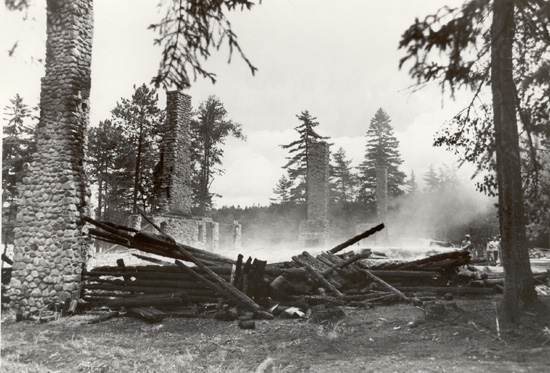
CLUBS
Explorer's Club.
46 East 70th Street, New York, New York 10021, USA.
The Explorers Club has had as members many Antarcticans of note and not unexpectedly its Tudor revival clubhouse at 46 East 70th Street in New York has a rich and eclectic array of artifacts, art and memorabilia with South Polar associations. Although a private club, non-members with a serious interest may arrange a visit by contacting the staff ahead of time.Another Byrd related item: The ship's bell from the Bear (pictured below).Among the items that caught my eye:
• In the Members Room on the ground floor, a large oil painting by Anton Widlicka entitled Springtime at Little America, a "byrd"'s eye view of Little America; a painting by Margaret Fernald Dole (1896-1970) of Byrd in uniform peering down at a globe; a color lithograph (?) noted as 18/100 of Amundsen in a parka; a bronze bust of Lincoln Ellsworth, sculpted and signed by Sally Clark c1933; and a large watercolor portrait of a jaunty looking Sir Hubert Wilkins.
• Also on the ground floor is a slightly larger than life-size bronze bust of Byrd, head upraised (pictured below). On the back is what appears to be "E GLICKSTEIN NY 5 Aug 1928".
• On the stairway wall are numerous framed photographic portraits, mostly signed. Among the Antarcticans: Scott, Amundsen, Shackleton, Byrd and his dog, Igloo.
• On an upper floor corridor hang several framed watercolors of US Antarctic operations in the 1960s by Arthur Beaumont.
• On the top floor is a marvelous high-ceilinged room crammed with lots of interesting things: A stuffed Emperor penguin, a pick-axe with the notation "this pick was used in the construction of his [Scott] base shelter . . ." accompanied by a signed photograph of Scott standing in front of the Discovery hut, and a bronze bust of Scott by Sally Clark, dated 1934 (although bearing little resemblance to Scott).
• The Club also has a variety of Byrd items in its archives including a board game, scrapbooks, two brown fur mitts, a US Navy Course & Distance Indicator and two beautifully made (by Ed Moody) miniature wooden sledges complete with papier-mâché sled-dogs and a tent.
[Episode 43, Low-Latitude Antarctic Gazetteer, posted April 12, 1997.]



PUBS, HOTELS AND RESTAURANTS
Ebenezer's Place.
417 Waverly Street, Route 135, Framingham, Massachusetts 01702-6939, USA.
This old Richardsonian railroad station in downtown Framingham (where Sir Hubert Wilkins died in 1958) once housed a restaurant named Ebenezer's Place after the Dicken's character. When I last visited it in 2006 it was closed. But some years ago, at least, it had various Byrd memorabilia on display including a sledge.

Little America.
I-80, Exit 68, Little America, Wyoming 82929, USA.
Years ago, driving across the country, I remember coming upon Little America, a gas station-cafe-shop complex on an isolated stretch of Highway 30 in Granger, Wyoming. For miles billboards announced its location, "just ahead." It's still there, at Exit 68 on Interstate 80, west of Rock Springs. A recent postcard my cousin sent me recounts the story:"Back in the eighteen nineties when Little America's founder was a young man herding sheep in a dreary section of Wyoming, he became lost in a raging northeast blizzard and was forced to camp out all night at the place where the original Little America now stands. On that long January night, in a terrible storm, with fifty-mile per hour winds and 40 below temperatures, he longed for a warm fire, something to eat and wool blankets. He thought what a blessing it would be if some good soul would build a house of shelter at that desolate spot. Many times in his heart he dreamed of a haven for travelers with a crackling fire, a warm bed, delicious food. In the nineteen-thirties when he saw Admiral Byrd's picture of "Little America" in the Antarctic and his isolation so many miles from his base camp, it reminded the founder of his experience in the Wyoming blizzard. The thought came back to fulfill his dream, to erect a haven of refuge on the spot of his harrowing experience. The name, of course, was a natural "Little America." From its beginning on Wyoming's southwestern desert, Little America has grown to include properties throughout the Western United States."Another postcard shows one of the buildings with a cupola on top; at each corner there stands what appears to be a penguin [youcan just make these out on the newer postcard below]. On display inside is a glass case containing a stuffed Emperor. The caption reads:"This penguin was presented to Little America many years ago by Captain Lystadt a member of Admiral Byrd's expedition to the South Pole. It was originally intended that it should arrive in this country alive, but climatic change was too severe and the penguin died enroute to Boston. It was stuffed in the east. The penguin here displayed is known as "emperor." It stands over three feet in height and weighs from 120 to 130 pounds." [Isak Lystad (sic) was Captain of the North Star during Byrd's third expedition.]There are also Little Americas in Cheyenne, Flagstaff and Salt Lake City.
[Episode 60, Low-Latitude Antarctic Gazetteer, posted May 10, 1998.] There is now a Penguin Grill at Little America.


SHIPS, BOATS, PLANES AND TRAINS (AND BITS OF SAME)
Byrd's aircraft, Stars & Stripes.
Virginia Aviation Museum, Richmond International Airport, 5701 Huntsman Road, Sandston, Virginia 23150-1946, USA.
Next on my trip was a stop at the Virginia Aviation Museum on the periphery of the Richmond International Airport. I had heard that the Stars and Stripes, a plane used by Richard Byrd during his first Antarctic expedition, was here. Sure enough, there it sits, restored and nicely displayed along with a number of other vintage aircraft. In front of the plane is yet another dogsled! [The plane is on loan from the Natonal Air and Space Museum.]The Museum's website gives this information on the plane:The explanatory plaque reads: "On January 15, 1929, this Fairchild FC-2W2 became the first aircraft to fly over Antarctica [this honor more accurately falls to Sir Hubert Wilkins who flew over parts of the Peninsula the year before]. Stars and Stripes was one of a complement of three aircraft Commander Byrd took with him on his first expedition to the bottom of the world. The other aircraft were a Fokker Universal, the Virginia, and the Ford Trimotor Floyd Bennett, which made the famous flight over the South Pole. Among Byrd's achievements aboard the Stars and Stripes was the discovery of the heretofore unknown mountain range which he named after the Rockefellers. There was also the rescue of the Virginia's hapless crew after the Fokker was destroyed on the ground by high winds while out on a survey mission. The Stars and Stripes provided stalwart service throughout this expedition and the 1934 expedition setting out caches of fuel, food [and] equipment as well as flying scientific survey missions. When Stars and Stripes was shipped back to the United States, it had flown a total of 187 grueling Antarctic hours. The aircraft was subsequently used by different owners as a barnstorming ship, a crop duster, photoship and hangar queen. Fairchild eventually took ownership again and in 1962 donated Stars and Stripes to the Smithsonian. Stars and Stripes is a loan of the National Air & Space Museum in recognition of this museum's location on what used to be known as the Richard Evelyn Byrd Flying Field."
The Museum also has in its collections, although not on display, such Byrd artifacts as a parka, gloves and a sun compass.
[Episode 55, Low-Latitude Antarctic Gazetteer, posted December 20, 1997.]
Virginia's Adm. Richard E. Byrd used this airplane on his legendary expeditions to the Antarctic. On Jan. 15, 1929, the Stars and Stripes became the first American aircraft to fly over the Antarctic. In 1930 the Stars and Stripes was stored in a hangar of snow blocks until, in late 1934, she was dug out and resumed service during Byrd’s second expedition. After returning to the United States in 1935, the Stars and Stripes was used for barnstorming, crop dusting and aerial photography. In 1957 Fairchild Aircraft Co. re-acquired the Stars and Stripes and, in 1961, donated the plane to the Smithsonian's National Air and Space Museum where it was restored to its original condition.The FC-2W2 was a larger version of the standard Fairchild FC-2W and was powered by a 450-horsepower Pratt & Whitney Wasp radial engine. The FC-2W2 was a rugged work plane with excellent short field and climb characteristics and a large cargo capacity. FC-2W2s were used to transport people and cargo in the world's most rugged terrain. The FC-2W2 has Fairchild's unique fold-back wings, and was available with skis or metal pontoons.
The fuselage is built of welded steel tubing and wooden fairing strips. The wings are made of spruce spars, and spruce and plywood ribs. The tail-group is a welded steel tube structure, and the horizontal stabilizer is adjustable in flight. The aircraft is fabric-covered.
On loan from the National Air and Space Museum
Serial No. 140Specifications for Fairchild FC-2W2
General:
Type: 5- to 7-seat utility aircraft
Manufacturer: Fairchild Aircraft Co., Farmingdale, Long Island, N.Y.
Date: 1928
Number Built: 31
Cost: UnknownPower Plant: Pratt & Whitney Wasp, 450-horsepower, 9-cylinder air-cooled radial engine. Dimensions:
Length: 33 feet, 2 inches
Height: 9 feet, 6 inches
Wingspan: 50 feetWeights and Measures:
Empty Weight: 2,732 pounds
Useful Load: 2,768 pounds
Maximum Gross Weight: 5,500 pounds
Fuel Capacity: 148 gallons (Stars and Stripes: 300 gallons)
Oil Capacity: 12 gallonsPerformance:
Maximum Speed: 134 mph
Cruise Speed: 108 mph
Landing Speed: 55 mph
Rate of Climb: 875 fpm at sea level
Service Ceiling: 15,000 feet
Cruising Range: 750 miles (Stars and Stripes: 1,500 miles)


Figurehead from the Bear.
Boston, Massachusetts, USA.
The State Street Bank in Boston has long had a large and interesting collection of New England and maritime artifacts, paintings, decorative items and such things as ship figureheads. These used to be on display back when the bank had branch offices. Most of the collection is now either in the executive offices of the bank or perhaps in storage. Years ago Allan Forbes, the chairman of the bank, wrote or oversaw the writing of many booklets on New England history many of which featured the collection. A 41-page title published in 1950 focused on figureheads and that was where I first learned about the Bear (the line drawing below is from that publication). This is what the booklet says about the figurehead:The figurehead shown on the cover, which is on view in our Trust Department., was on the Bear of Oakland during the U. S. Antarctic Expedition of 1939-41 commanded by Admiral Richard E. Byrd. It was carved by W. A. Robertson, who spent three years on board the Bear with the second Byrd Expedition, and has been loaned indefinitely (we hope) to the State Street Trust Company by Mr. and Mrs. Robertson. Its features were damaged by contacts with the ice, the jaw and mouth later being restored by the Navy. Admiral Byrd used her on both of his previous Antarctic Expeditions and was responsible for making a number of discoveries and for exploring a previously unknown area of several hundred square miles. She served the U. S. in the Arctic during World War II. The Bear's history is long and interesting; it was built in Greenock, Scotland as early as 1874. First used as a whaler, then purchased by the U. S. to rescue the Greely party, she saved many persons each year in the Arctic. Also, she was used to maintain order at Nome at the time of the gold rush in 1899-1900. In 1912 Stefansson was brought out on the Bear and in 1923 Amundsen was carried from Wainwright to Nome; Captain Robert A. Bartlett used her to save Stefansson's vessel in 1914. Bought by the City of Oakland in 1928, she was re-christened Bear of Oakland."At a dinner in Boston I found myself sitting next to a State Street Bank vice president and I asked her whether she knew the whereabouts of the figurehead. She did some digging and found that it was (in 2000) in the Chairman's office. She arranged for me to come by and have a look and it was then that I took the photos below. Polly Burrough's book, The Great Ice Ship Bear, adds this interesting detail to the story. The Bear had a role in the 1930 movie "The Sea Wolf." It's role was to play Death Larsen's sealer, the Macedonia. The historic ship had a not very proud ending. A Philadelphia restauranteaur bought the Bear for $12,500 with the intention of turning it into a restaurant and museum. When she was being towed from Halifax to Philadelphia, a storm arose, the towline snapped and the ship started to take on water. On March 19, 1963, she sank ninety miles south of Cape Sable. The Bank's figurehead is not the original one. The remains of that (certainly an earlier one if not the actual original) was given by Byrd to the Mariners' Museum in Newport News (see No. 048 above). The Peabody Essex Museum (see No. 360 above) has a "brass plate from a life boat built in Scotland in 1871, presumably for the ship Bear," and the Explorers Club in New York has the Bear's ships bell (see No. 244 above). For further information of the Bear, go to http://www.antarctic-circle.org/ships.htm



Byrd's aircraft, Floyd Bennett.
Henry Ford Museum, Dearborn, Michigan, USA.
The Ford Tri-motor Floyd Bennett is the aircraft that Byrd, pilot Bernt Balchen, Harold June and Ashley McKinley flew from Little America over the South Pole on November 28-29, 1929. The Tri-motor was the first commercially successful, all metal aircraft and was produced between 1925 and 1933. It's length was 50 feet; wingspan, 78 feet. Also in the Museum is the Josephine Ford, which Byrd and Floyd Bennett flew over the North Pole in 1926.


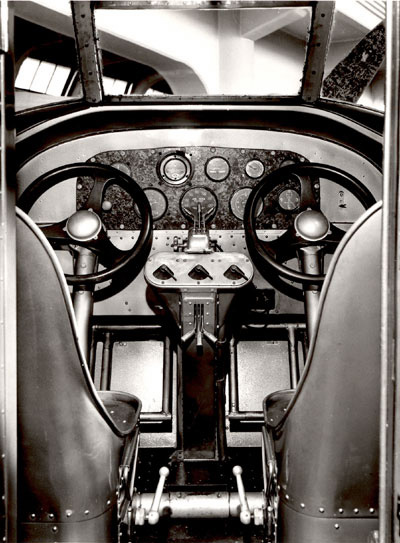
USS Richard E. Byrd.
Location unknown.
This U.S. Navy ship was named for Byrd. It was designated DDG-23 (Charles F. Adams Class) and was launched February 6, 1962 and commissioned just over two years later. Length: 437 feet. Beam: 47 feet. Draught: 22 feet. It was decommissioned in 1990 and sold to Greece. It's present name and status are unknown.

USNS Richard E. Byrd.
Due to be launched April 2007.
The USNS Richard E. Byrd (T-AKE-4) will be a Lewis and Clark-class dry cargo ship in the United States Navy. She is second United States Navy ship to be named for the polar explorer, Rear Admiral Richard Evelyn Byrd. The contract to build her was awarded to National Steel and Shipbuilding Company (NASSCO) of San Diego, California, on 18 July 2003. She is scheduled to be part of the Pacific Fleet.She was laid down on 15 July 2006, is due to be launched in April 2007 and is estimated to be commissioned in October 2007. She will be 689 feet in length and 106 feet in beam.
Source: http://www.answers.com/%20topic/usns-richard-e-byrd

SCHOOLS
Richard E. Byrd Elementary School.
68 Terakubo, Naka-Ku, Yokohama, Japan 231-0855.

Admiral Richard E. Byrd Middle School.
134 Rosa Lane, Winchester, Virginia 22602, USA.

Admiral Richard E. Byrd Elementary School.
265 Wellington Avenue, Elk Grove Village, IL 60007, USA.
Richard E. Byrd Community Academy.
363 West Hill St., Chicago, Illinois, USA.

Richard E. Byrd Middle School.
9171 Telfair Avenue, Sun Valley, California 91352, USA.

Byrd Polar Research Center.
Scott Hall, 1090 Carmack Road, The Ohio State University, Columbus, Ohio 43210, USA.
Scott Hall is a modern building of two stories and a basement. Named for Scott?! Not the same one. This Seott was a former president of the university. There are various artifacts, paintings, and displays through the building, in a glass-fronted display case and in the Goldthwait Library. [I've been a visitor here several times and the exhibits change, so what appears below may not all be on display at any one time.] Some highlights: 1. Full-length standing statue of Byrd (by de Weldon) in foyer to building. According to Brian Shoemaker this came from Reedsport, Oregon. Nearby are two snowshoes mounted on the wall. 2. Byrd's sleeping bag is stretched out on a metal map filecase in a room next to the library on the ground floor. It's shedding hairs. Also in this room is a wood crate on which is written: "R. E. Byrd 9 Brimmer Street Boston, Mass Books." 3. A Polaris snowmobile sits in a corridor on the ground floor. Caption: "This Polaris snowmobile was used extensively in the United States Antarctic Program pulling a Nansen sled. It transported scientists and their equipment to research sites." 4. Several oil paintings hang in the Goldthwait Polar Library on the ground floor. One is by Peter McIntyre showing penguins in the foreground and icebergs and ships in background. Another one by McIntyre showing Cape Hallett. Also a framed photo of Lincoln Ellsworth. Colored photographic portraint of Byrd in formal uniform with medals. Several glass-fronted bookcases with better books. Coatrack with articles of polar clothing hanging on it. Several penguin motif items. 5. Along the corridors are many modern maps and posters. 6. There are also oil paintings and other items associated with the Arctic.In the ground floor display case near the library are a number of items:
1. Two large ice anchors from the City of New York. 2. What appears to be a whale harpoon. 3. Two red and green brass running lights from the City of New York. 4. Ship's wheel from the City of New York. 5. Ship's brass telegraph plate. 6. Brass binnacle. 7. Wood rigging block with three holes. 8. Three mounted photographs. The one in the center shows Byrd with an American flag tied to a rock. The caption reads: "Admiral Byrd just before taking off for the South Pole holding the flag and a stone from Floyd Bennett's grave which he dropped at the Pole." The photo to the right is of The City of New York tied up to the Ice Barrier. The photo on the left is the ice-covered bow of Admiral Byrd's flagship The City of New York. 9. Plaque that reads: "The City of New York artifacts donated to the Byrd Polar Research Center Archival Program by Robert Wiskoff, Garibaldi, Oregon, 1994."In the auditoriumn on the second floor are several items:
On either side of the stage are oil portraits of, to the left, Sir Hubert Wilkins, and to the right (stage left) his wife. On the wall on the right are two sledges, the upper one supposedly associatedwith Byrd. On the wall to the left are 2 iceaxes, the bottom one supposedly Wilkins'. There is also a wooden airplane ski association with a Byrd plane. At the nearby OSU archives are stored the Byrd papers and some artifacts (see No. 557 above). His journal is there. Also there are papers of the Frederick Cook Society, Sir Hubert Wilkins, the papers of the American Polar Society. There is a box of matches that has written on it "From Amundsen's cache, brought back by Geological Party BAC. Left by Amundsen January 6, 1912."Byrd Watching in Ohio.
Sadness reigns tonight in Columbus as the heavily favored Buckeyes of Ohio State University, the nation's top-ranked football team, fell to the Michigan State Spartans. But a month ago, the campus built around a football stadium, was a cheerier hub of activity as perhaps 200 people congregated at the Byrd Polar Research Center for the American Polar Society's "Polar Pioneers" Symposium. During those two days I found ample opportunity to poke around in search of Antarcticana. As I walked from the parking lot the first thing that struck me was the name of the building where BPRC resides: Scott Hall! One wonders who plans such things. As you enter you're greeted in the foyer by a bronze statue of Byrd, the same as the one at Arlington National Cemetery, by Felix de Weldon. Apparently, this was previously in Reedsport, Oregon. On a nearby wall are mounted two snowshoes. The main point of interest on the ground floor is the Goldthwait Polar Library. Other than a good supply of books and journals, there are several paintings displayed: a couple of Peter McIntyre's with penguins and icebergs, one set at Cape Hallett. Also, a framed photograph of Lincoln Ellsworth and a tinted colored photographic portrait of Byrd in formal uniform. In a corner stands a coat rack on which hang bits and pieces of polar clothing, and throughout are odds and ends of the penguin motif variety. In a nearby room stands a line of metal map cases on the top of which lies a sleeping bag once used by Byrd; it must be reindeer or similar as it's in a full state of shedding! Also here is a wood crate that bears the printed inscription "R. E. Byrd, 9 Brimmer Street, Boston, Mass, Books." Out in the corridor is a glass-fronted case displaying items associated with Byrd's ship, The City of New York. A plaque notes: "City of New York artifacts donated to the Byrd Polar Research Center Archival Program by Robert Wiskoff, Garibaldi, Oregon, 1994." Among the items: two large ice anchors; what appears to be a whale harpoon; two red and green brass running lights; the ship's wheel, brass telegraph plate, brass binnacle and a wood rigging block; and three mounted photographs. The one in the center shows Byrd with an American flag tied to a rock. The caption reads: "Admiral Byrd just before taking off for the South Pole holding the flag and a stone from Floyd Bennett's grave which he dropped at the Pole." The photo to the right is of The City of New York tied up to the Ice Barrier. The photo on the left shows the ship's ice-covered bow. On a back corridor of the ground floor is a snowmobile. The caption reads: "This Polaris snowmobile was used extensively in the United States Antarctic Program pulling a Nansen sled. It transported scientists and their equipment to research sites." Elsewhere along the corridors throughout the building are modern-day maps, posters and photographs of both arctic and antarctic subjects. The BPRC auditorium is on the second floor and on display are some interesting objects. Flanking the stage are large standing oil portraits of Sir Hubert Wilkins and his wife. On the side walls hang two sledges, the upper one apparently associated with Byrd; opposite are two ice axes, the bottom one used by Wilkins. Below that is a wooden aircraft ski from one of Byrd's planes. Not far away is the University Archives building with its fixed stacks that seemingly reach to the heavens. Here reside the Byrd papers as well as collections associated with Sir Hubert Wilkins, the Frederick A. Cook Society, and the American Polar Society. One of the artifacts that caught my eye was a box of matches on which was written: "From Amundsen's cache, brought back by Geological Party BAC. Left by Amundsen January 6, 1912." [Episode 68, Low-Latitude Antarctic Gazetteer, posted November 7, 1998.]On a later visit I found that the Archives had recently bought via Ebay a field desk from Richard C. Black who was on the 1939-40 expedition. Mahoghany, quite large, ca. 2x1.5x3 feet, all for $100. The December 1999 issue of the Center's Ice Sheets newsletter reports a new accession, a glass bottle. Text of article:
From Ohio to the Bottom of the World and Back Again: An Extra-ordinary Journey Ends by Raimund E. Goerler Picture a glass bottle, approximately 6 inches tall and clear, that is tossed into a body of water. Now, imagine that the person tossing the bottle is in Antarctica and the body of water is the ocean surrounding Antarctica. Considering the tossing waves of the ocean, floating ice, passing ships, and children playing on a beach, t he chances of that bottle surviving for nearly seventy years are as unlikely as a Buckeye victory in Ann Arbor. Yet, that is exactly what happened to the latest acquisition for the Byrd Polar Research Center Archival Program: a bottle set adrift by a member of Admiral Richard Byrd's first expedition to Antarctica, 1928-30. The bottle itself originated in Ohio and was specially made by the Owens Bottle Company of Toledo for the Byrd Antarctic Expedition. Imbedded in the glass of the bottle itself is a representation of one of Byrd's airplanes for the expedition and the statement "Byrd Antarctic Expedition, 1928-1929." Aside from its special face, there was nothing unusual about the bottle, which is the size and type of four ounce prescription bottles used in drug stores in the 1920's. Byrd himself ordered five hundred of these ordinary bottles for a special purpose. His plan was to place messages concerning the progress and accomplishments of the expedition into the bottles and from time to time set them adrift as "Silent Messengers of Science." At the time, the bottles and their messages were to serve as either records of advancement to and from Antarctica or as relics of disaster. Very few of these bottles have survived. The one which is now part of the Papers of Admiral Richard E. Byrd was found on the beach at St. Martin's Island, Otago Harbor, near New Zealand at least ten years ago. In late October, a friend of the Byrd Archival Program alerted the archivist that it was available for purchase on E-Bay, the electronic auction house on the World Wide Web. Several days of bidding, during which there were only nine bids followed and the bottle became the property of The Ohio State University at a nominal price. It is the only bottle in the massive --1.5 million items-- Admiral Richard E. Byrd Papers. OSU's Byrd Polar Research Center acquired Byrd's Papers in 1985. The OSU Libraries, the University Archives, which houses and references the collection, and the Byrd Polar Research Center have collaborated to make the collection available to scholars. (See http: //www.lib.ohio-state.edu/arvweb.) The bottle will be part of the special exhibit in Sills Gallery of the Main Library next fall. In September the OSU Libraries will host a traveling exhibit concerning the history of exploration in Antarctica, entitled "Echoes In the Ice." In addition to the traveling exhibit, the Libraries will feature items from its own polar collections, including the Papers of Admiral Richard E. Byrd. Plans for social and educational events are still in development at this time.


GRAVES, CAIRNS, MEMORIALS, STATUES
Byrd statue.
Avenue of Heroes, Arlington National Cemetery, Arlington, Virginia, USA.
Richard E. Byrd, America's most famous Antarctic explorer, died on March 11, 1957, in Boston and three days later was buried at Arlington National Cemetery across the Potomac from Washington, D.C. If you visit the cemetery (open every day; parking and a handy Metro stop) you'll find yourself walking to the Visitor's Center along Memorial Drive (or the Avenue of Heroes). On the north side roughly opposite the Center you'll see, high on a white marble base, Felix de Weldon's bronze life size statue of Byrd in polar clothing. The Admiral is standing, feet apart, fists clenched, and head upraised. There is what appears to be a full-size model for the sculpture on the ground floor of the Byrd Polar Research Center at Ohio State and a small version at the U.S. Navy Museum in Washington, D.C. (046, pictured above). [The Byrd busts at McMurdo Station (014), the Canterbury Museum (021) in Christchurch and Unity Park, Dunedin, New Zealand (063) are also by de Weldon as is the monumental Iwo Jima Memorial also in Arlington.] The inscriptions on the marble base read:On front: Richard Evelyn Byrd | Rear Admiral United States Navy | October 25, 1888. March 11, 1957 | [device] | Upon the bright globe he carved | his signature of courage | erected by National Geographic Society. On the west side: [Round map showing Antarctica] | Valiant leader of | five antarctic expeditions 1928-1957 | which revealed the secrets of | half the great white continent. On east side: [round map of north pole area] | First to fly over the north pole 1926 | and the south pole 1929 | A pioneer conqueror of the Atlantic by air 1927. [Higher up:] Felix W. De Weldon Sc. 1961. On north side: [A long listing of all his awards and medals from 1926-1960, including the Medal of Honor 1927.]


Byrd's grave.
Arlington National Cemetery, Arlington, Virginia, USA.
Byrd's grave is on Roosevelt Drive, not far from the Visitors Center; the hand-out map highlights it (Specific Interment Location: Section 2, Grave 4969-1, Map grid WX-32/33). As you walk up towards it you can see the Custis-Lee Mansion rising in the background. The marker itself is a "regulation" service headstone that reads as follows (pictured below):[cross device] | RICHARD E | Byrd, JR | [Star Device] | Medal of Honor | RADM | US NAVY | OCT 25 1888 | MAR 11, 1957On the reverse side:2 4969-1 VIRGINIA | WORLD WAR I & II | NC—DSM & GS | LM & GS–DFC–CR | FIRST FLIGHT OVER | NORTH POLE | MAY 9 1926 |Within a few feet to the east is a similarly designed headstone for Byrd's son, Richard, and his mother. It reads (pictured below):[cross device] | RICHARD E. | BYRD, JR. | US NAVY| WORLD WAR II | FEB 19 1920 | OCT 3 1988. [Both the Admiral and his son apparently used the term junior. And the Admiral's father was Richard E. Byrd II]On the reverse side (pictured below): 2 4968-8 | MARIE A. | HIS WIFE | JAN 19 1889 | SEP 3 1974
[Although it seems odd, the inscription for the Admiral's wife, Marie, is indeed on the back of the son's marker. Bolling Byrd Clarke told me that was, indeed, done in error which ties into Site 330 below.]
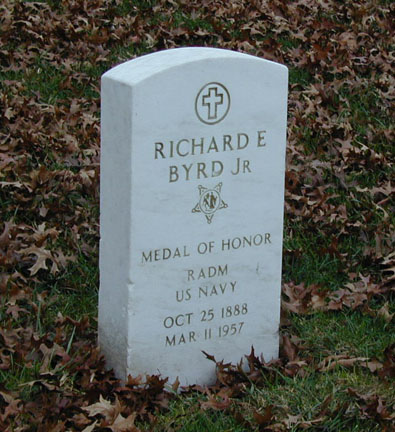


Boulder slated for Byrd' gravestone.
Edward T. Bryand Global Sciences Building, University of Maine, Orono, Maine, USA.
I went to see this rock in 1998 after reading the following Boston Globe article, which appeared 12 July 1998:ANTARCTIC BOULDER A LINK TO ADMIRAL BYRD'S EXPEDITIONSIn Episode 39, Adm. Richard Byrd's gravesite in Arlington National Cemetery was described. I commented that it seemed odd that the inscription for Marie Byrd, the Admiral's wife, appears on the back of the son's marker (rather than the husband's) and, further, that the names of both the son and the father read the same, Richard E. Byrd, Jr. Curious about this I contacted some Byrd family members and learned the following: "My mother's and brother's names on the same stone and the Jr. after both my father's and brother's names are mistakes. A memorial was to be erected some time ago at which time the problem was to be resolved. Unfortunately, plans for the memorial fell through to be completed at some future date." One wonders whether such a memorial will ever materialize. When I described the Byrd boulder in Maine to someone in the UK and said that it might very well be the largest piece of Antarctica outside of Antarctica, I was told—not so fast! There's a pretty big one in front of the British Antarctic Survey headquarters in Cambridge. So the next time I was in the area I drove out to BAS and had a look (pictured below). Without question, it's a smaller rock! Bob Headland told me that it had been brought from Signy Island around 1989.
By Donna Gold GLOBE CORRESPONDENTORONO, Maine - Among the summer term arrivals to the University of Maine here is a half-ton granite boulder.
Now, lugging granite to Maine is generally about as productive an enterprise as carrying coals to Newcastle: Maine is littered with granite boulders, remnants of receding glaciers from the Ice Age.
But the newly arrived rock has very different origins. Winds of salt and sand from an Antarctic desert as dry as the Sahara sculpted the rock, carving a tunnel through one side and a deep depression into its top. According to professors at the university, it is possibly the largest stone from that continent in North America.
The boulder is on loan here thanks to a chain of friendships that links the university to Admiral Richard E. Byrd, the man who is said to have been the first to fly over both the North and South poles. It was his eldest daughter, E. Bolling Byrd Clarke, who loaned the rock to the university, which is known for its scientific expeditions to Antarctica.
The rock was supposed to have been placed on Admiral Byrd's grave (he died in 1957) at Arlington Cemetery in Virginia. Instead, it has languished in a shed at the cemetery for about seven years, gathering a greenish mold from the damp. While Clarke still views this sculptural stone as a fitting tribute to a man who planned some of the earliest expeditions to the South Pole, her sisters were not so sure.
Speaking from her home in Pennsylvania, Clarke declined to comment on the reasons for her siblings' second thoughts, saying only, "there's a difference of opinion as to whether or not it should be used; until we decide, we're loaning it to the university."
It's a sultry summer day when two university professors show off the rock in its current home at the Edward T. Bryand Global Sciences Building. The rock is about three and a half feet round—of perfect hugging size.
But like a moon rock, this boulder probably had no connection to any form of life for most of its 300 million years, for the polar desert where it had settled was too cold for anything to live. It is likely that no bug or lichen, no amoeba or moss had touched the stone until Harold Borns, a professor of geology at the University of Maine and a longtime friend of the Byrd family, picked it to be hoisted on a helicopter sling, swung out from its arid, boulder-strewn field and carried north in 1991.
In some ways, the arrival of the stone to Maine after the great effort of bringing it to Byrd's gravesite is an anti-climax. Its journey is also one that oddly mirrors the fits and starts of Byrd's reputation, which has recently come into question. . . .
Several of those well-publicized excursions were planned in Maine at the explorer's home on Tunk Lake in the town of East Sullivan. (See No. 863 above.)
"We spent many summers there and they were the happiest times of our lives," Clarke said. "We were together as a family. That was something that was difficult to do with my father as busy as he was, and so well known."
According to Clarke, he wrote a book about a year spent in Antarctica, titled "Alone," while they were in East Sullivan. . . .
"Byrd was one of the real pioneers in starting scientific work in Antarctica," Jacobson said. "The stone is a reminder of a beautiful place most people have not had the chance to see and a fitting tribute to the long connection between the university and the Byrd family."


Grave of Igloo.
Pine Ridge Cemetery for Small Animals, Pine Street, Dedham, Massachusetts, USA.
In suburban Boston, Massachusetts, in the Pine Ridge Cemetery for Small Animals in Dedham, is a large roughly shaped pinkish stone with the carved inscription: "IGLOO. He was more than a friend." Igloo was, of course, the faithful canine companion of Richard Byrd, and the stone marks his grave. The fox terrier travelled everywhere with Byrd and was an expeditionary veteran of both the Arctic and Antarctic. He was even the subject of a biography: Igloo by Jane Brevoort Walden (G. P. Putnam's, 1931). [Episode 15, Low-Latitude Antarctic Gazetteer, posted 13 July 1996.]

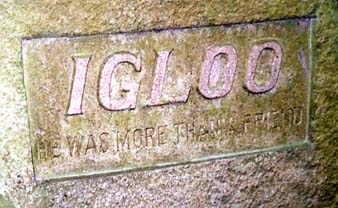
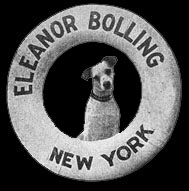
Byrd bust.
McMurdo Station, Ross Island, Antarctica.
This bust was sculpted by Felix de Weldon who also did the full-size statue of Byrd at Arlington National Cemetery (013, above), the bust at the Canterbury Museum in Christchurch (021, above) and the one in Unity Park, Dunedin, New Zealand (063, below) . As the older photo below shows it once stood in front of the old Chapel of the Snows. It's now in front of the NSF 'Chalet.' Not a 'Low-Latitude' site but included anyways.

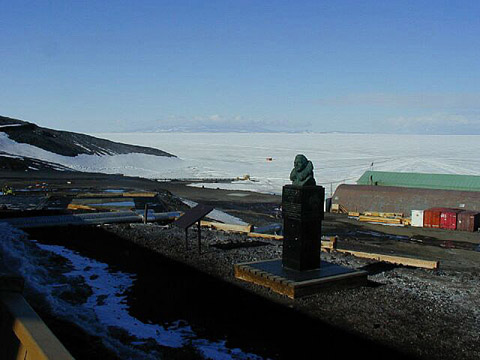
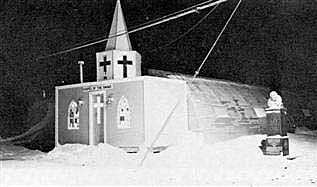
Byrd bust.
Upper Unity Park, Eglinton Road, Dunedin, New Zealand.
This bronze bust, sculted by Felix de Weldon and the same as the one at McMurdo Station (014, above), was presented to Dunedin by the National Geographic Society and unveiled on 31 October, 1967, by the U.S. Ambassador to New Zealand, the Honorable John F. Henning.A bronze plaque on the half-ton, black-granite base commemorates Admiral Byrd's antarctic achievements:
From Dunedin on December 2, 1928, sailed the City of New York and the Eleanor Boiling to carry to Antarctica under Admiral Byrd's command the first expedition to explore the frozen continent by air. Under the valiant leadership of the "Admiral of the Ends of the Earth," five Antarctic expeditions 1928-1957 revealed the secrets of half the great white continent.On a pedestal near the statue is a bronze medallion depicting the relationship of Dunedin to Little America. Like the bust at McMurdo Station, the Dunedin bust is a partial copy of a full-length statue on the "Avenue of Heroes" in Washington, D.C. [actually Arlington, Virginia. See 013 above). The only other such copy is in the National Geographic Society's Washington headquarters.Source in part: Antarctic Journal, January/February 1968

Byrd Memorial.
Mt. Victoria, Wellington, New Zealand.
When I first saw this memorial to Byrd on a hilltop overlooking Wellington back in 1991, it was a bit worse for wear. The bronze plaque was missing and grass was growing up through the flagstones. It has since been refurbished. Originally, the tent-like structure, which faces south to Antarctica, was encrusted with stones from the southern continent. Within the 'tent' stood and still stands a bust of Byrd. The 'tent,' however, has changed and now is covered with tiles that are the work of Doreen Blumhardt. They depict the Aurora Australis. The surrounding landscape treatment has been changed as well.Here's some information on the original plaque at the Memorial which may have been updated during the refurbishment:
Dedicated 11 March 1962The Memorial was re-dedicated on June 21, 1993. Both Bolling Byrd Clarke and Ruth Siple were there as special guests. New plaques were installed including one in stone commemorating Paul Siple:
Unveiled Rt Hon Keith Holyoake, Prine Minister
Dedicated Rev. W. E. D. Davies, National Council of Churches
Architects: Orchiston, Power & Associates
Builders: Wilkins & Davies Constuction Ltd.
Sculptor: Thomas V. Johnston RA
Landscaping: Edward Hutt, Esq. W.C.C.
Conception: Richard E. Byrd Fellowship, New ZealandDr. Paul A. Siple | 1909-1968 | Paul Siple accompanied Admiral Byrd to | the Antarctic on three expeditions in | 1928-30, 1933-35, and 1939-41. He later | undertook three other Antarctic | expeditions including the leadership of | the scientific team at the United States | South Pole station in 1956-57. Dr. Siple | became one of the foremost authorities | on the geography of Antarctica, polar | logistics and the principles governing | the adaptation of humans to life in cold | regions.


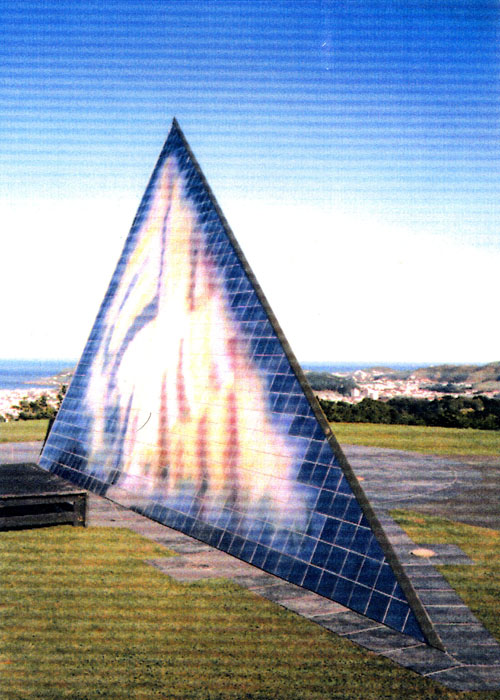
Byrd statue.
Winchester/Frederick County Joint Judicial Center, Cameron Street, Winchester, Virginia, USA.
I'm of the opinion that this life-size bronze statue of Byrd sculpted by Dr Jay Morton ranks as the second worst example of Antarctic public art. (What's the worst? The busts of the brothers McCarthy in Kinsale, Co. Cork, Ireland, No. 560.) The face bears little resemblance to the explorer. Attached to Byrd's leg is loyal Igloo.It was unveiled on 14 July 1997. The statue is set on a white stone base on which is affixed a bronze plaque that reads:
Admiral Richard Evelyn Byrd | 1888-1957 | The Winchester native attended The Virginia Military | Institute, The University of Virginia, and graduated | from the U. S. Naval Academy, 1912. | He was a pioneer aviator and Polar explorer. In 1926, | he was the first to fly over the North Pole for which he | was awarded the U.S. Congressional Medal of Honor. In | 1927, with three companions, he flew the Atlantic, | flight time 42 hours. | Admiral Byrd commanded five expeditions to the | Antarctic to explore the unknown regions from the air. | In 1929, Byrd, as navigator, with three companions, became the first to fly to the South Pole returning to his base | Little America located on the face of the Ross Ice Shelf, | a 19 hour flight. | In 1933, a second Byrd expedition extended the | exploration of Antarctica and continued scientific observations. | During the Antarctic winter of 1934, Byrd spent five months | alone in a hut at a weather station named Bolling Advance | Base. The base was named for his mother who lived at | 326 Amherst Street, Winchester, where the Admiral was | born. Admiral Byrd commanded three subsequent expeditions | and discovered and mapped 537,000 miles of Antarctic | territory. He was officially cited 22 times for bravery or | conspicuous conduct. | Admiral Byrd is buried in Arlington National Cemetery. | Dr. Jay Morton, Sculptor Commemorated July 14, 1997

Byrd statue.
Punta Arenas, Chile.
I've been told that a statue of Byrd is in this city, a common jumping-off place for the Antarctic, but I've never been able to confirm it.
Grave of Bernt Balchen.
Arlington National Cemetery, Arlington, Virginia, USA.
Just to the west of the Byrd's marker in Arlington Natonal Cemetery is a larger granite memorial to Bernt Balchen (1899-1973), a member of the first BAE in 1928 and the pilot of the Floyd Bennett on the historic 1929 flight to the South Pole. He was also the chief pilot on Ellsworth's 1933-34 and 1934-35 Antarctic expeditions. Norwegian born, he became an American citizen in 1931.The inscription on the face of the marker reads: BERNT BALCHEN | COLONEL, U.S. AIR FORCE | 1899–1973
On the reverse side: [Device] | "TODAY GOES FAST AND TOMORROW IS ALMOST HERE. | MAYBE I HAVE HELPED A LITTLE IN THE CHANGE. | SO I GO ON TO THE NEXT ADVENTURE, LOOKING TO | THE FUTURE BUT ALWAYS THINKING BACK TO THE PAST, | REMEMBERING MY TEAMMATES AND THE LONELY PLACE | I HAVE SEEN THAT NO MAN EVER SAW BEFORE . . . " | BERNT BALCHEN | –4969–2
On the south edge: A Masonic device. On the north edge: The device of The Explorers Club.
Balchen's widow told me that the inscription above was written by Corey Ford, who for many years was the Writer in Residence at Dartmouth College.
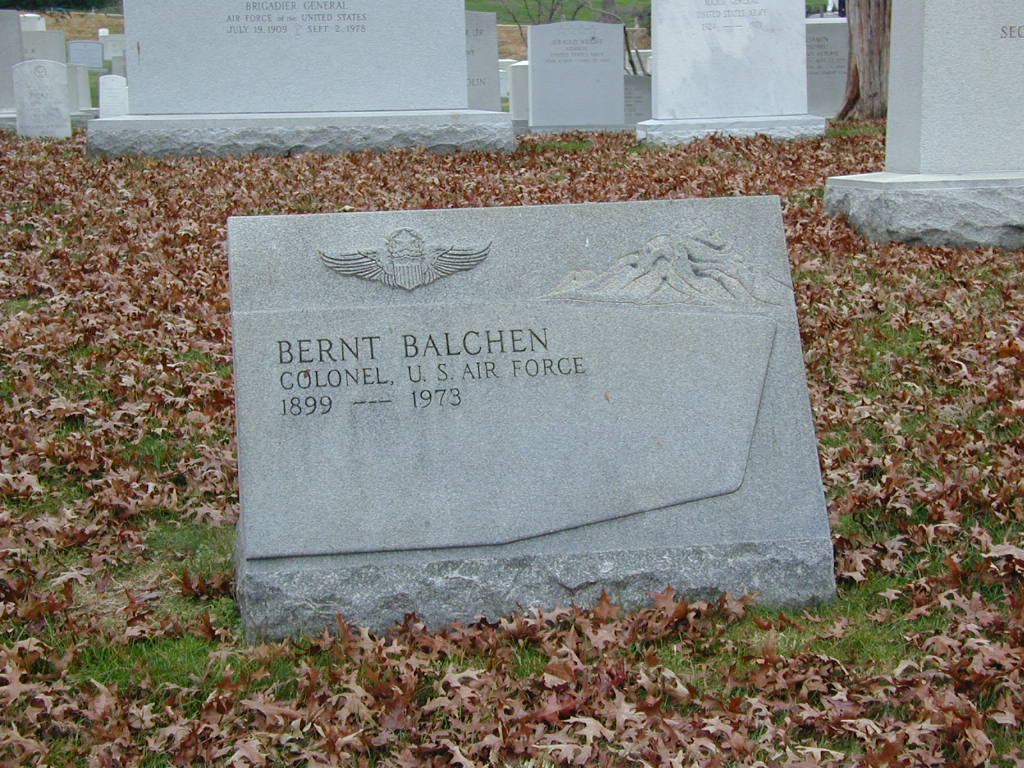
Grave of Finn Ronne.
Arlington National Cemetery, Arlington, Virginia, USA.
Front of marker: Finn Ronne | Captain | U.S. Naval Reserve | Polar Explorer | December 20, 1899 - January 12, 1980 | Horten, Norway - Bethesda, Maryland
At top is carved scene with navy anchor, dogsled, mountains. Back of marker: Ronne | Finn Ronne | Byrd Antarctic Expedition II 33-35 | U.S. Antarctic Service Expedition 39-41 | Ronne Antarctic Research Expedition 46-48 | I.G.Y. Antarctic Expedition 56-58 | Legion of Merit Medal | Elisha Kent Kane Medal | Explorers Club Medal | Royal Order of St. Olav Medal | [at bottom] Ronne Ice Shelf, Antarctica
In upper left corner is the Explorers Club flag.



Those looking at the back of the gravestone are (L to R): David Wilson (grandnephew of Dr. Edward A. Wilson), Myrna Fawcett, Jackie Ronne (Finn Ronne's widow who with Jennie Darlington were the first women to overwinter in the Antarctic and for whom the Ronne Ice Shelf is named), her daughter Karen Ronne Tupek in the penguin jacket (a third generation Antarctican) and partially obscured, Brenda Clough, author of May be Some Time, a science fiction novella featuring L.E.G. Oates. (This was taken on 2 December 2001. David Wilson had spoken the evening before at the Cosmos Club.
Carl Eklund's grave.
Arlington National Cemetery, Arlington, Virginia, USA.
Standard marble marker with cross. Front of marker: Carl | Robert | Eklund | Wisconsin | Maj | US Army | World War II | Jan 27 1909 | Nov 3 1962 Back of marker: 1 142-W-C | His Wife | Harriet May | Feb 13 1910 | Mar 19 1996 Grave located at Section 1, Grave 142-W-CDr. Carl Robert Eklund, posthumous Fellow of the Arctic Institute of North America, prominent in arctic and antarctic research, Chief of the Polar and Arctic Branch of the U.S. Army Research Office, died on November 3, 1962 at the age of 53. His gregarious friendly nature, good humour and knack of story-telling made him a cherished friend of all who knew him. For 23 years he was a leading American specialist in ornithology and geographic research in both the north and south polar regions. His U.S. Government service in the Department of the Interior and the Department of the Army was approaching 29 years. Carl was born in Tomahawk, Wisconsin on January 27, 1909. After completing his secondary schooling at Tomahawk High School in 1927, he attended the University of Wisconsin for a year before transferring to Carlton College where he received his B.A. degree in 1932, majoring in biology and minoring in education. For the next 3 years he served as a forestry foreman in the Shenandoah National Park in Virginia. As a graduate fellow of the Cooperative Wildlife Research Unit, Oregon State College, he received his M.S. degree in 1938, specializing in fish and wildlife management, botany, and animal husbandry. From Corvallis, Oregon he returned to government service as a junior biologist at Seney National Wildlife Refuge in Michigan. With solid training and experience he answered the lure of the polar regions. From 1939-41 he served as ornithologist at the East Base of the U.S. Antarctic Service. This was the first modern US. Government-sponsored expedition to Antarctica, and the third of Rear Admiral Richard E. Byrd's Antarctic commands. In addition to his collection of animal life for the Department of the Interior, Fish and Wildlife Service, Carl made one of the longest antarctic dog sled journeys accompanying Finn Ronne in a landward encirclement of Alexander I Island from the Palmer Peninsula Station on Stonington Island. Islands sighted near the turning point of this journey were named the Eklund Islands in his honour by the Board of Geographical Names. From 1941 to 43 he returned to the U.S. Fish and Wildlife Service as research biologist in charge of game conservation and education on Indian reservations at Minneapolis, Minnesota. During World War I1 he served as commissioned officer, advancing to Major in the U.S. Army Air Force. He served in the Arctic Section of the Arctic Desert Tropic Information Center. After the War he returned in 1946 to the employment in the U.S. Fish and Wildlife Service, working as a research biologist in the Office of River Basin Studies. After a year in Portland, Oregon, he moved on to Chicago and later to Washington, D.C., and was in charge of the Wildlife Section of this study program. His steady career development in the U.S. Fish and Wildlife Service was marked in 1954-56 by appointment as Assistant Regional Director of the Atlanta, Georgia office. The call of the polar regions drew him south again. His skill and experience were needed by the IGY organizers of the National Academy of Sciences. He was appointed as the first Scientific Station Leader of the Wilkes Station, Antarctica. His field leadership was outstanding, and he vigorously pursued his own program of biological and ornithological research. His bird banding program became international in scope around the entire continent. His field studies provided a basis for his doctoral thesis on the south-polar skua. He received his Ph.D. in zoology and geography from the University of Maryland in 1959. To maintain an intimate pursuit of polar research he accepted in 1958 the position of Chief of the Polar and Arctic Branch, Environmental Research Division of the U.S. Army Research Office, Washington, D.C. In this capacity he directed an extensive inter-disciplinary research program in the Arctic, necessitating frequent visits to Greenland and Alaska. Meanwhile, he served on the National Academy of Sciences Committee on Polar Research advising on research for Antarctica. His national and international reputation grew rapidly and his services as a lecturer and consultant on polar matters were in constant demand. His selection as the first president of the Antarctican Society of Washington, D.C. was a natural one. Dr. Eklund's publications during the last 20 years, mostly on zoological and ornithological topics, number close to 30. His first book, co-authored with Joan Beckman, "Antarctica, Land of Science", was in draft form at the time of his death. It is scheduled for publication by Holt, Rinehart and Winston in 1963. Although Carl's passing came suddenly without an indication of ill health, he lived a full life. One might well say that he crowded experiences of two or three normal lifetimes into his allotted span. He was recipient of many honours. He is survived by his wife, Harriet, and two teen-age daughters, Linda and Signe. Their home was a constant meeting point of visiting polar and biological friends not only from America but also from South America, Europe, Australia, and New Zealand, where his many travels had taken him. In spite of average build, his warm human kindliness, his mischievous humorous blue eyes, broad smile, short-cropped hair, and ready wit interspersed with clearly thoughtout serious observations made him a colourful figure in the polar world at its critical transition from the days of hard-fought polar discoveries to the modern research area.

PLACES
Chinook Kennels.
Route 113A (westside), Wonalancet (ca. 6 miles north of Tamworth village.), New Hampshire, USA.
Chinook Kennels, Wonalancet, New Hampshire. "At the southern edge of New Hampshire's White Mountains lie a trio of tiny villages—Wonalancet, Sandwich and Tamworth—which from the mid-1920s through the end of World War II were the crown jewels in a dog sled empire . . ." [Source: "On the Trail of Legends," by Nancy Cowan, October 1993 issue of Dog World.]Arthur Walden's Chinook Kennels were located in Wonalancet on Route 113A, and it was there that the sled dogs—Alaskan Malamute and Siberian huskies—for all three Byrd expeditions were raised and trained. An official state historical marker (Antarctic was misspelled on the first version!) commemorates the site. One will also find there a memorial stone dedicated in 1938 by Byrd "To all Noble Dogs" who gave their lives in U.S. service. And a third stone, with a dog sled engraved on it, memorializes the Seeleys who owned and ran the kennels for many years after Walden retired. (Arthur Walden was chief dog driver on Byrd's first expedition; refer to Norman Vaughan's book, With Byrd at the Bottom of the World; The South Pole Expedition of 1928-30, for some interesting views on Walden.)
[Episode 19, Low-Latitude Antarctic Gazetteer, posted August 17, 1996.]The State historical marker beside Route 113A reads:
CHINOOK KENNELS Purchased and moved to this site in 1930 | by Milton and Eva B. "Short" Seeley, these kennels | produced sled dogs for exploration, racing, and | showing. For almost 50 years Chinook Kennels | exerted a profound influence upon the Alaskan | Malamute and Siberian Husky breeds, and many | champions were born here. With Milton directing, | dog teams were sent on the Byrd Antarctic | Expeditions and to the Army's Search and Rescue | units. After his death in 1943, Eva continued | alone. An author, sled dog racer, and dynamic | contributor to the sport of dogsledding, "Short" | was named to the Musher's Hall of Fame in Alaska. | Mrs. Seeley died in 1985 at age 94.In addition to the State marker is a nearby boulder with a bronze plaque attached that reads:Admiral Byrd Memorial | to | all noble dogs | whose lives were given on dog treks | during the two expeditions to | Little America, Antarctica | to further science and discovery | 1928-1930 1933-1935 | Dedicated October 8, 1938The third marker is a recent (1988) granite slab with a dogsled depicted. About 100 feet further north is a garage that has in its gable a sign that reads: "Chinook Kennels" with a representation of a husky. The kennels were originally about a mile away from where the markers are, according to Nancy Cowan. On the other hand, the photograph below of the building in a distressed state, may have something to do with the Chinook Kennels—or may not.
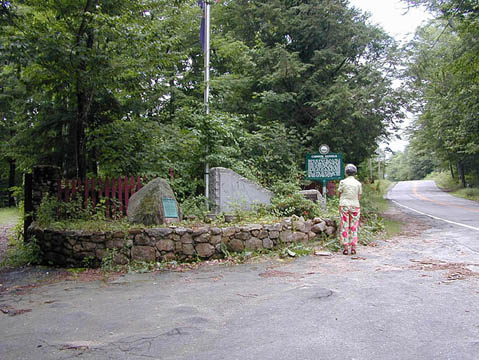


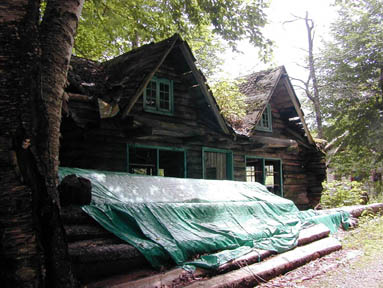
Quail Island.
Lyttelton Harbour, New Zealand
Although Byrd used Dunedin rather than Lyttelton as a base for his 1928-30 expedition (BAEI) and 80 dogs were quarentined on Quarentine Island in Otago Harbour, 15 dogs were kept at Quail Island in Lyttelton. They were later sent to Mt. Cook where they were trained on the Tasman Glacier. These were the last Antarctic dogs to be on Quail Island.

Richmond International Airport.
1 Richard E. Byrd Terminal Drive, Richmond, Virginia, USA.
When I was at the Virginia Aviation Museum (No. 070, see above), I asked if there was anything related to Byrd at the airport just up the road. Absolutely not, I was told. Years ago I learned not to believe much I was told when seeking out 'Low-Latitude Sites,' so I drove the extra mile or less to the airport and parked in an area where signs said my car would be towed if I stayed even for one minute more than ten. I ran in and had a look to the left and a look to the right, and saw an informaton booth. I asked about any Byrd plaques or statues or displays, etc., that might be in the airport. They kind of stared at me in disbelief. (After 9/11 they would have called security). My ten minutes were fast running out. I ran up the stairs to the second level and went along a way looking all the time and seeing nothing. I saw a set of back stairs down to ground level and headed down and as I turn on the landing, what do I see but TWO PAINTINGS!
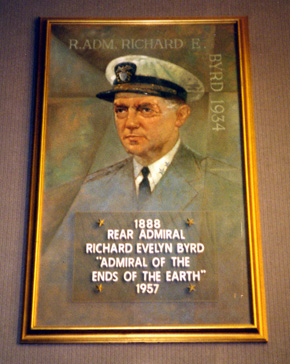
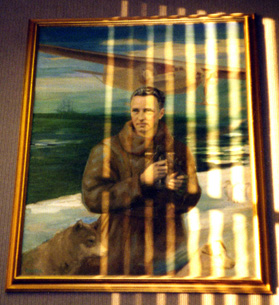
1888 | Rear Admiral | Richard Evelyn Byrd | "Admiral of the | Ends of the Earth" | 1957.The notation on the other oil painting reads:
"Oil painting of Admiral Richard E. Byrd. Captain Charles L. Kessler, accompanied Admiral Byrd on first three expeditions to the North and South Pole. Loaned by Rita Kessler Barte."
TOPOGRAPHIC FEATURES
Moon crater named for Richard E. Byrd..
Moon
Byrd (lunar crater)
Crater characteristics:
Coordinates: 85.3° N, 9.8° E
Diameter: 94 km
Depth: Unknown
Colongitude: 10° at sunrise
Eponym: Richard E. Byrd
Byrd is an irregular lunar crater that is located near the north pole of the Moon. The north rim of Byrd is nearly connected to the Peary crater, a formation that is adjacent to the pole. The smaller Gioja crater is attached to the remains of the southwest rim. The rim of Byrd crater is worn and eroded, with sections distorted by intruding crater rims along the perimeter. As a result the crater interior is longer in the north-south direction than it is wide. There is a gap in the western rim, and the southern rim is now little more than a low ridge on the surface. Some time after the original impact the crater interior was covered in lava flows, leaving a nearly flat surface that is marked only by tiny craterlets. There is no central peak at the mid-point of the interior, and no ridges of significance.
By convention these features are identified on lunar maps by placing the letter on the side of the crater mid-point that is closest to Byrd crater.
Byrd Latitude Longitude Diameter
C 84.7° N 26.8° E 52 km
D 85.4° N 32.7° E 24 km
Source: Wikipedia, the free encyclopediaNo photograph can be found of the crater.
OTHER AND SUNDRY
American flag from Byrd.
The Mountain Club, Loon Mountain, Kancamagus Highway, Lincoln, NH 03251-6710, USA.
The Mountain Club is a hotel at Loon Mountain in Lincoln, New Hampshire. I was there in 1993 for a conference and came upon a display case in the lobby that featured various memorabilia associated with Sherman Adams, President Eisenhower's chief of staff; Adams was involved in some way with the development of this ski area. Next to a sterling silver lunch box and thermos (which apparently Adams took daily to the White House!) is a small American flag. The caption notes, in part, that the flag was carried by Richard E. Byrd to the north and south poles and was given to Sherman Adams on November 12, 1954. A letter from Byrd states: "I carried [the flag] with me over the North Pole in 1926 . . .[and] on the following Antarctic expeditions: 1928-30, 1933-35, 1939-41, 1946-47. This flag was also with me on our flight over the South Pole in 1929 and all of my major flights of exploration. It was also with me when a combination of unforeseen circumstances forced me to spend the winter night alone at scientific duties in the shadow of the South Pole."
[Episode 2, Low-Latitude Antarctic Gazetteer, posted April 6, 1996.] LLAG: EPISODE 2:
